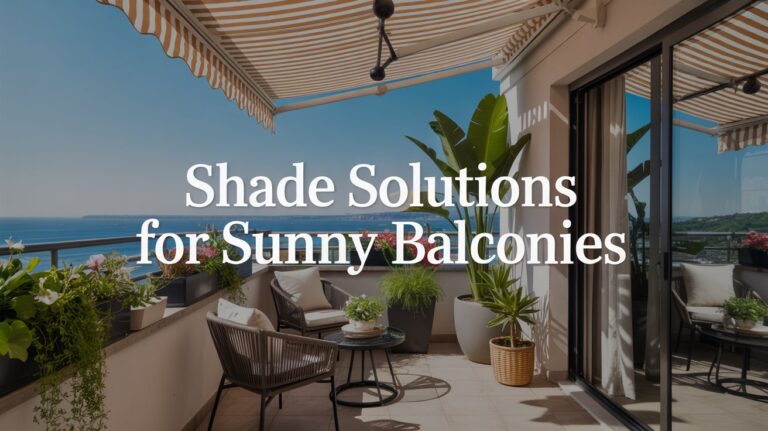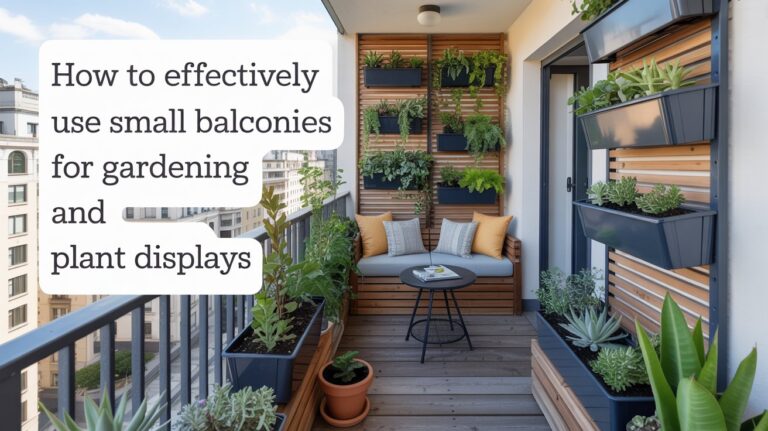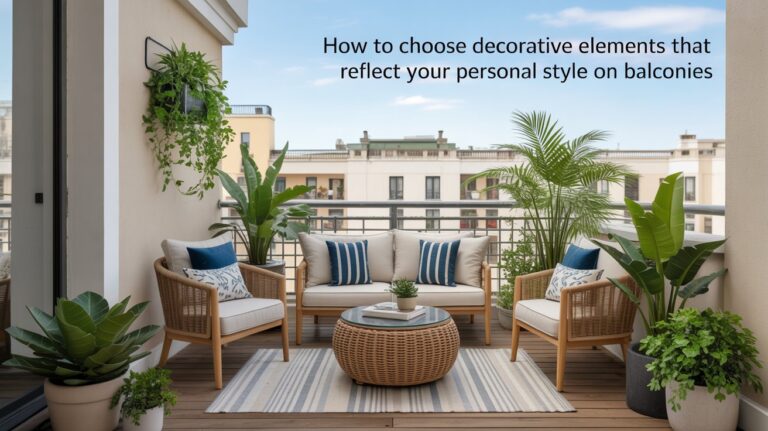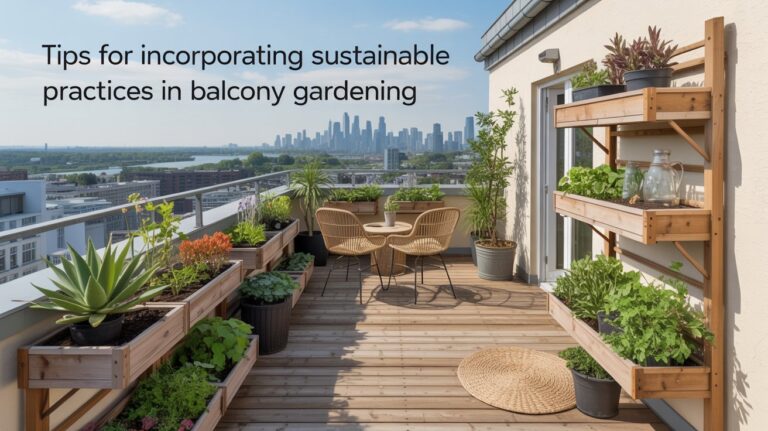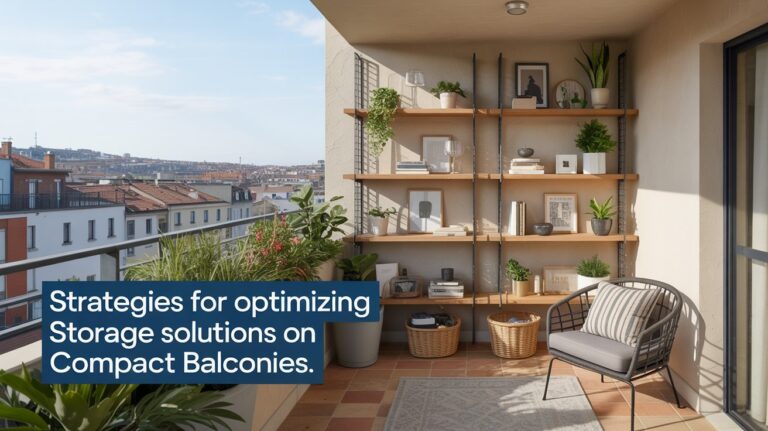The Impact of Railing Design on Balcony Safety and Aesthetics
I have been, or can be if you click on a link and make a purchase, compensated via a cash payment, gift, or something else of value for writing this post. As an Amazon Associate, I earn from qualifying purchases. Please read my full Affiliate Disclosure for more information.
Railing design directly affects balcony safety and aesthetics by governing fall protection, wind resilience, and how light and sightlines interact with the façade. Material choices, spacing, and mounting details dictate obstruction-free paths, edge protection, and corrosion resistance, while height, handrail geometry, and attachment methods influence load paths and dynamic forces. Aesthetics emerge through transparency, glare, and material language that harmonizes with the building’s facade. Keep refining geometry and materials now, and you’ll reveal deeper performance insights ahead.
Key Takeaways
- Material choice affects durability, maintenance, and appearance, influencing long-term safety and aesthetic harmony with the building.
- Railing height, spacing, and anchoring details ensure fall protection, code compliance, and resistance to wind and freeze–thaw cycles.
- Gap and edge design balance occupant safety with visibility and privacy, shaping perceived openness and light patterns.
- Aesthetic integration—geometry, materials, and sightlines—enhances curb appeal while maintaining ruggedness and maintenance practicality.
- Prototyping and field considerations (tolerances, glare, and maintenance) predict performance, safety, and visual impact over time.
Railing Material Choices: Balancing Durability and Style
When selecting railing materials, durability and style must be weighed together to guarantee long-term performance without compromising aesthetic goals. You assess material properties, corrosion resistance, and load requirements, translating them into reliable performance forecasts. Metal options offer high strength and precise decorative patterns, though finish maintenance varies by environment. Wood delivers warmth and versatility but may demand treatments and frequent sealing. Composite materials fuse durability with low upkeep, expanding color options without sacrificing rigidity. Glass provides transparency and modernity, yet edge protection and mounting details matter. You balance these factors with budget and installation constraints, prioritizing predictable behavior and visual coherence.
Spacing Standards and Fall Protection: Ensuring Safety
Spacing standards set the baseline for safe operation across railing systems, building on the material choices discussed earlier by tying panel gaps, posts, and balusters to occupant protection and code compliance. You’ll balance aperture size, edge protection, and attachment methods to reduce fall risk while preserving balcony privacy and weather resilience.
1) Ensure gap measurements meet code limits without compromising visibility or privacy.
2) Select anchoring methods that maintain strength in wind and freeze–thaw cycles.
3) Incorporate continuous inspection routines to verify obstruction-free paths and corrosion resistance.
Height Requirements: How Tall Should a Balcony Railing Be
Typical projects follow Standard Height Guidelines to make certain consistent railing heights across the structure. Variations by Use matter, since residential, commercial, and balcony edge conditions can justify adjustments to meet code and user needs. Safety Considerations drive the final decision, balancing reach, fall protection, and engaging with local amendments.
Standard Height Guidelines
Standard balcony railing heights are defined to prevent falls and guarantee structural reliability, with guidelines typically anchored by regional codes. You’ll evaluate how height standards influence safety, usability, and aesthetics, focusing on measurable outcomes and material implications. Consider how variation in height affects load paths, fall risk, and inspection cycles, then align with local requirements.
1) Balcony railing heights: verify compliance, assess impact on fall prevention, and confirm continuous construction documentation.
2) Railing material choices: analyze stiffness, connection detailing, corrosion resistance, and maintenance implications for long-term performance.
3) Practical testing: document tolerances, height adjustments, and accessibility considerations to ensure consistent safety outcomes.
Variations by Use
Height requirements for balcony railings vary by use, and the intent behind each use case drives the targeted height range and allowable tolerances. You assess occupancy, potential load paths, and exposure to impact when selecting heights, ensuring code-compliant ranges while preserving usability. For decorative patterns, you balance open-space ratios with grip requirements, confirming that patterns don’t compromise barrier integrity. Color schemes influence perception of height but not structural performance; choose contrasting hues to enhance visibility without reducing safety margins. You document tolerances precisely, noting site-specific refinements and maintenance implications, so that appearance, accessibility, and safety remain aligned across use variants.
Safety Considerations
To determine the appropriate railing height, you must balance fall protection requirements with practical usability, considering occupancy type, expected loads, and exposure to potential impact. You’ll assess code compliance, material behavior, and installation tolerances to guarantee reliability while preserving aesthetics like decorative patterns and color schemes.
1) Align height with local codes and design intent, prioritizing safe fall resistance without compromising access.
2) Evaluate loading scenarios, wind exposure, and dynamic contact forces for keyboard-like interactions near edges.
3) Integrate decorative patterns and color schemes so safety elements remain visible and legible in various lighting conditions.
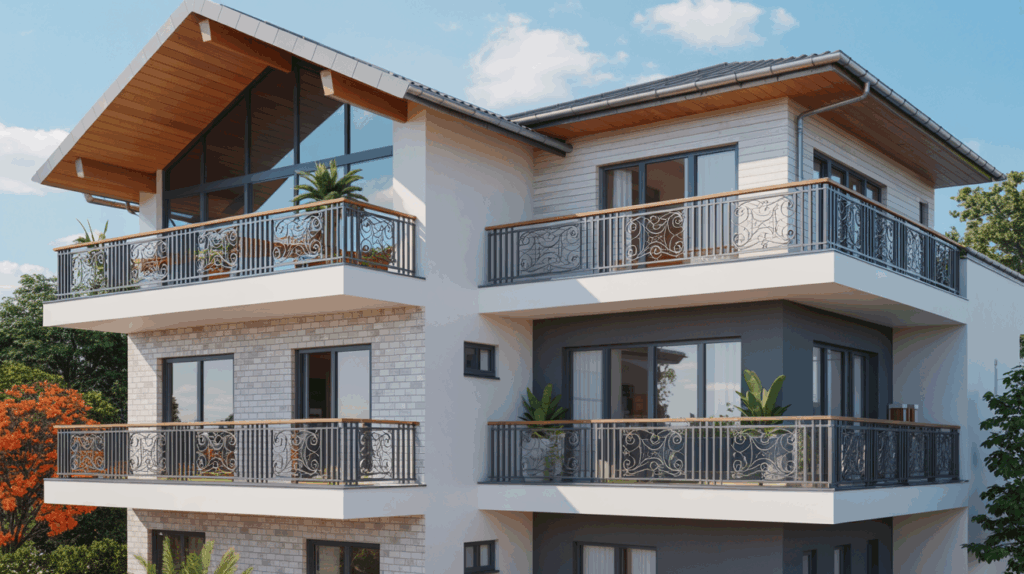
Load-Bearing Details: Structural Integrity in Design
Load-bearing details are the backbone of balcony railing design, and precise calculations guarantee the structure can safely transfer loads from the railing to the supporting elements. You assess member sizes, connection types, and load paths to ensure stiffness, redundancy, and compliance with codes. Critical factors include moment transfer, shear capacity, and deflection limits under live and wind loading. You account for joint detailing, corrosion protection, and thermal movement, maintaining long-term performance. Decorative accents and weather resistance influence material selection without compromising strength. By documenting presumptions and safety margins, you enable predictable behavior and verify design integrity throughout service life.
Aesthetics and Light: How Railing Design Shapes Ambiance
You’ll examine how material transparency and light interaction with rails influence the perception of space and mood on a balcony. Consider how varying opacity and patterning control daylight diffusion, create shadows, and affect privacy without sacrificing view lines. This analysis sets up how subtle design choices in materials and railing geometry shape ambiance through light play.
Material Transparency Effects
Material transparency profoundly influences the perceived openness and light quality of a balcony, because the choice of materials—glass, tempered metal, or perforated panels—modulates both glare and visual connection to the exterior.
- You evaluate glass opacity as it governs glare control, visibility, and perceived space without sacrificing safety margins.
- You assess metal mesh or perforated panels for selective transparency, balancing privacy with exterior reference points.
- You compare maintenance, durability, and weathering effects to guarantee consistent aesthetic performance over time, including glass opacity and metal mesh durability considerations.
Light Play Through Rails
Light play through rails shapes perceived space by translating exterior illumination into interior ambiance, where rail geometry, spacing, and shading patterns govern the distribution of shadows and highlights. You evaluate how railing color interacts with daylight to alter perceived depth, texture, and contrast on adjacent surfaces. Rails with tighter spacing yield denser shadow mats, while wider gaps reveal background detail, changing scale perception. Consider how railing decorative elements cast intentional silhouettes during different sun angles, influencing mood and readability of outdoor-into-indoor progressions. Selecting railing color and decorative elements carefully maintains legibility, reduces glare, and harmonizes material language with overall balcony design.
Maintenance Considerations: Longevity of Different Materials
Longevity varies by material, with the most durable options resisting corrosion, UV damage, and mechanical wear over decades. You evaluate materials by long-term performance, not initial appearance, focusing on actionable maintenance needs and life-cycle costs.
- corrosion resistance: quantify expected degradation cycles and protective coatings that extend life.
- maintenance frequency: link intervals to environmental exposure, load, and system design thresholds.
- data-driven selection: compare expected service lives, repaint or seal requirements, and total cost of ownership for each material.
Careful documentation of these factors informs safer, more durable balcony railing choices and reduces unforeseen service interruptions.
Architectural Integration: Harmonizing With Building Façade
Architectural integration starts with aligning balcony railing design to the building’s façade language—ensuring lines, proportions, and materials reinforce a cohesive exterior while meeting safety and performance requirements. You assess how railing geometry mirrors overall massing, spacing, and rhythm of the façade, avoiding visual discord. Material choices should reflect local context and ornamentation sensibilities, balancing minimalism with tactile accuracy. Consider decorative balustrades where appropriate, ensuring detailing doesn’t disrupt line continuity. Acknowledge historical influences to respect heritage while leveraging modern performance standards. The result is a façade-aware system that maintains structural integrity, user comfort, and stylistic harmony across elevations.
Practical Design Tips: Combining Safety With Visual Appeal
When balancing safety and aesthetics, prioritize code-compliant sizing, glazing, and handrail geometry to create a balcony that performs under load while remaining visually coherent.
- Always evaluate field conditions, component tolerances, and connection details to minimize deflection and maximize rigidity.
- Explore innovative railing types and eco friendly material options that meet performance criteria without sacrificing clarity of line.
- Prototype or model sightlines, glare, and maintenance needs to ensure long-term appeal and safety.
This approach yields durable, visually integrated balustrades that respect codes, reduce life-cycle costs, and enhance perceived quality.
Conclusion
Balcony railings blend safety with style, and precision matters at every step. You must balance material durability, spacing, and height to meet code while preserving aesthetics. Structural integrity hinges on load-bearing details and proper connections. Consider light transmission and facade harmony to avoid visual heaviness. Maintenance plans extend longevity, so choose corrosion-resistant options and predictable service cycles. Integrate railing design with architectural intent from the outset, validating performance through testing and implementation reviews for reliable, visually cohesive outcomes.

